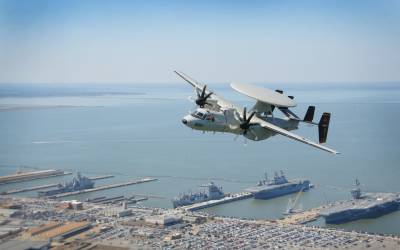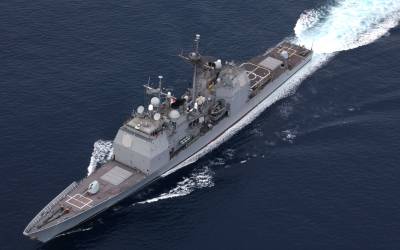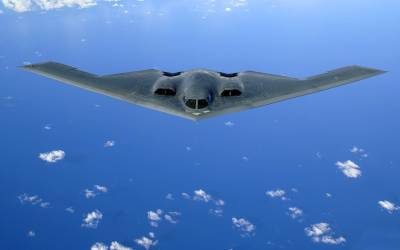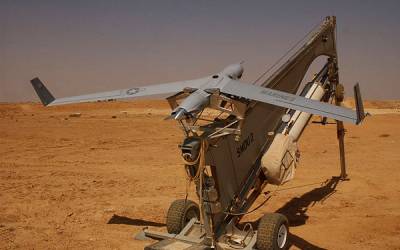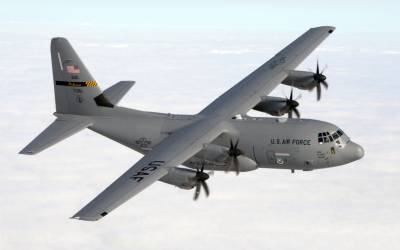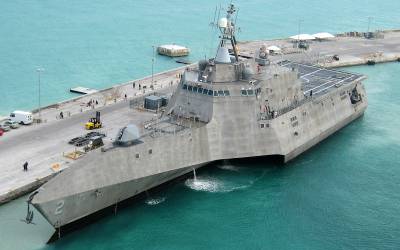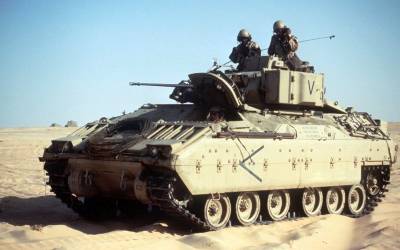April 26, 2024
E-2D Hawkeye: The Navy's New AWACS
(click to view full) Northrop Grumman’s E-2C Hawkeye is a carrier-capable “mini-AWACS” aircraft, designed to give long-range warning of incoming aerial threats. Secondary roles include strike command and control, land and maritime surveillance, search and rescue, communications relay, and even civil air traffic control during emergencies. E-2C Hawkeyes began replacing previous Hawkeye versions in 1973. […]
Full Article Status: paid
April 25, 2024
Serious Dollars for AEGIS Ballistic Missile Defense (BMD)
AEGIS-BMD: CG-70 launches SM-3 (click to view full) The AEGIS Ballistic Missile Defense System seamlessly integrates the SPY-1 radar, the MK 41 Vertical Launching System for missiles, the SM-3 Standard missile, and the ship’s command and control system, in order to give ships the ability to defend against enemy ballistic missiles. Like its less-capable AEGIS […]
Full Article Status: paid
April 23, 2024
USA's B-2 Bombers Leading the Way in Contracting for Availability
All together now… (click to view full) Britain’s practice of “contracting for availability” for key equipment, rather than paying for spare parts and maintenance hours, may be its most significant defense procurement reform. In a world where older air, sea, and ground vehicle fleets are growing maintenance demands beyond countries’ available budgets, it’s an approach […]
Full Article Status: free
April 17, 2024
Australia's MH-60R Maritime Helicopters
MH-60Rs fire Hellfire (click to view full) Australia’s AIR 9000, Phase 8 project aimed to buy 24 modern naval helicopters to 16 existing S-70B-2 Seahawks, along with the disastrous A$1.1 billion, 11-helicopter SH-2G “Super Seasprite” acquisition attempt. With a total sales and support value of over A$ 3 billion, it was a highly coveted award. […]
Full Article Status: free
April 12, 2024
From Dolphins to Destroyers: The ScanEagle UAV
ScanEagle launch (click to view full) ScanEagle’s base Insight UAV platform was originally developed by Washington state’s Insitu, Inc. to track dolphins and tuna from fishing boats, in order to ensure that the fish you buy in supermarkets is “dolphin-safe”. It turns out that the same characteristics needed by fishing boats (able to handle salt […]
Full Article Status: sample
April 11, 2024
KC-46A Pegasus Aerial Tanker Completes Firsts
KC-135: Old as the hills… (click to view full) DID’s FOCUS articles cover major weapons acquisition programs – and no program is more important to the USAF than its aerial tanker fleet renewal. In January 2007, the big question was whether there would be a competition for the USA’s KC-X proposal, covering 175 production aircraft […]
Full Article Status: paid
April 3, 2024
AH-64E Apache Block III: Evolving Battlefield Roles
AH-64 in Afghanistan (click to view full) The AH-64 Apache will remain the US Army’s primary armed helicopter for several more decades, thanks to the collapse of the RAH-66 Comanche program, and the retirement sans replacement of the US Army’s Armed Reconnaissance Helicopter (ARH). Apaches also serve with a number of American allies, some of […]
Full Article Status: paid
April 1, 2024
MQ-9 Reaper: Unfettered for Export
0 Reaper, ready… (click to view full) The MQ-9 Reaper UAV, once called “Predator B,” is somewhat similar to the famous Predator. Until you look at the tail. Or its size. Or its weapons. It’s called “Reaper” for a reason: while it packs the same surveillance gear, it’s much more of a hunter-killer design. Some […]
Full Article Status: paid
April 1, 2024
ER/MP Gray Eagle: Enhanced MQ-1C Predators for the Army
ER/MP, armed (click to view full) Its initial battles were fought within the Pentagon, but the US Army’s high-end UAV has made its transition to the battlefield. The ER/MP program was part of the US Army’s reinvestment of dollars from the canceled RAH-66 Comanche helicopter program, and directly supports the Army’s Aviation Modernization Plan. The […]
Full Article Status: paid
March 20, 2024
The C-130J: New Hercules & Old Bottlenecks
RAAF C-130J-30, flares (click to view full) The C-130 Hercules remains one of the longest-running aerospace manufacturing programs of all time. Since 1956, over 40 models and variants have served as the tactical airlift backbone for over 50 nations. The C-130J looks similar, but the number of changes almost makes it a new aircraft. Those […]
Full Article Status: paid
March 14, 2024
France's Rafale
Dassault Rafale (click for cutaway view) Will Dassault’s fighter become a fashionably late fighter platform that builds on its parent company’s past successes – or just “the late Rafale”? It all began as a 1985 break-away from the multinational consortium that went on to create EADS’ Eurofighter. The French needed a lighter aircraft that was […]
Full Article Status: sample
March 14, 2024
The MQ-4C Triton: Poseidon's Unmanned Herald
BAMS Operation Concept (click to view full) The world’s P-3 Orion fleets have served for a long time, and many are reaching the end of their lifespans. In the USA, and possibly beyond, the new P-8 Poseidon Multi-mission Maritime Aircraft will take up the P-3’s role. While the P-8’s base 737-based airframe offers strong service […]
Full Article Status: paid
March 13, 2024
The JAS-39 Gripen: Sweden's 4+ Generation Wild Card
South African JAS-39D (click to view full) As a neutral country with a long history of providing for its own defense against all comers, Sweden also has a long tradition of building excellent high-performance fighters with a distinctive look. From the long-serving Saab-35 Draken (“Dragon,” 1955-2005) to the Mach 2, canard-winged Saab-37 Viggen (“Thunderbolt,” 1971-2005), […]
Full Article Status: paid
March 5, 2024
Trident II D5 Missile: Keeping Up with Changing Times
Trident II D5 Test Launch (click to view full) Nuclear tipped missiles were first deployed on board US submarines at the height of the Cold War in the 1960s, to deter a Soviet first strike. The deterrence theorists argued that, unlike their land-based cousins, submarine-based nuclear weapons couldn’t be taken out by a surprise first […]
Full Article Status: paid
March 4, 2024
LCS: The USA's Littoral Combat Ships
Austal Team Trimaran LCS Design (click to enlarge) Exploit simplicity, numbers, the pace of technology development in electronics and robotics, and fast reconfiguration. That was the US Navy’s idea for the low-end backbone of its future surface combatant fleet. Inspired by successful experiments like Denmark’s Standard Flex ships, the US Navy’s $35+ billion “Littoral Combat […]
Full Article Status: sample
February 29, 2024
AMRAAM: Deploying & Developing America's Medium-Range Air-Air Missile
AIM-120C from F-22A (click for test missile zoom) Raytheon’s AIM-120 Advanced, Medium-Range Air to Air Missile (AMRAAM) has become the world market leader for medium range air-to-air missiles, and is also beginning to make inroads within land-based defense systems. It was designed with the lessons of Vietnam in mind, and of local air combat exercises […]
Full Article Status: paid
February 27, 2024
Virginia Block III: The Revised Bow
Virginia Block I-II (click for SuperSize) “GDEB Receives $148M as Virginia Class Lead Yard” described changes to the Virginia Class submarine’s design that are expected to reach 20% of the $200 million savings goal by the time orders for the versatile sea attack/ land attack/ special forces submarines rise to 2 per year, in 2012. […]
Full Article Status: free
February 21, 2024
Super Tucano Counter-Insurgency Plane Makes Inroads in Africa
Super Tucano Embraer’s EMB-314 Super Tucano trainer and light attack turboprop continues to rack up global orders, solidifying its position as the globe’s pre-eminent manned counter-insurgency aircraft. The latest order set of about $180 million expands the plane’s footprint into 3 African states: Angola, Burkina Faso, and Mauritania. They join Brazil, Chile, Colombia, the Dominican […]
Full Article Status: free
February 6, 2024
The US Army's Bradley Remanufacture Program
M3A3 Bradley CFV: Charge! (click to view full) In the 1970s, middle eastern wars demonstrated that tanks without infantry screens were vulnerable to infantry with anti-tank missiles. Unfortunately, armored personnel carriers were easy prey for enemy tanks, and sometimes had trouble just keeping up with friendly tanks like America’s 60+ ton, 50+ mph M1 Abrams. […]
Full Article Status: sample
February 1, 2024
Super Hornet Fighter Family MYP-III: Contracts
Breakthrough… (click to view full) The US Navy flies the F/A-18 E/F Super Hornet fighters, and has begun operating the EA-18G Growler electronic warfare & strike aircraft. Many of these buys have been managed out of common multi-year procurement (MYP) contracts, which aim to reduce overall costs by offering longer-term production commitments, so contractors can […]
Full Article Status: paid

